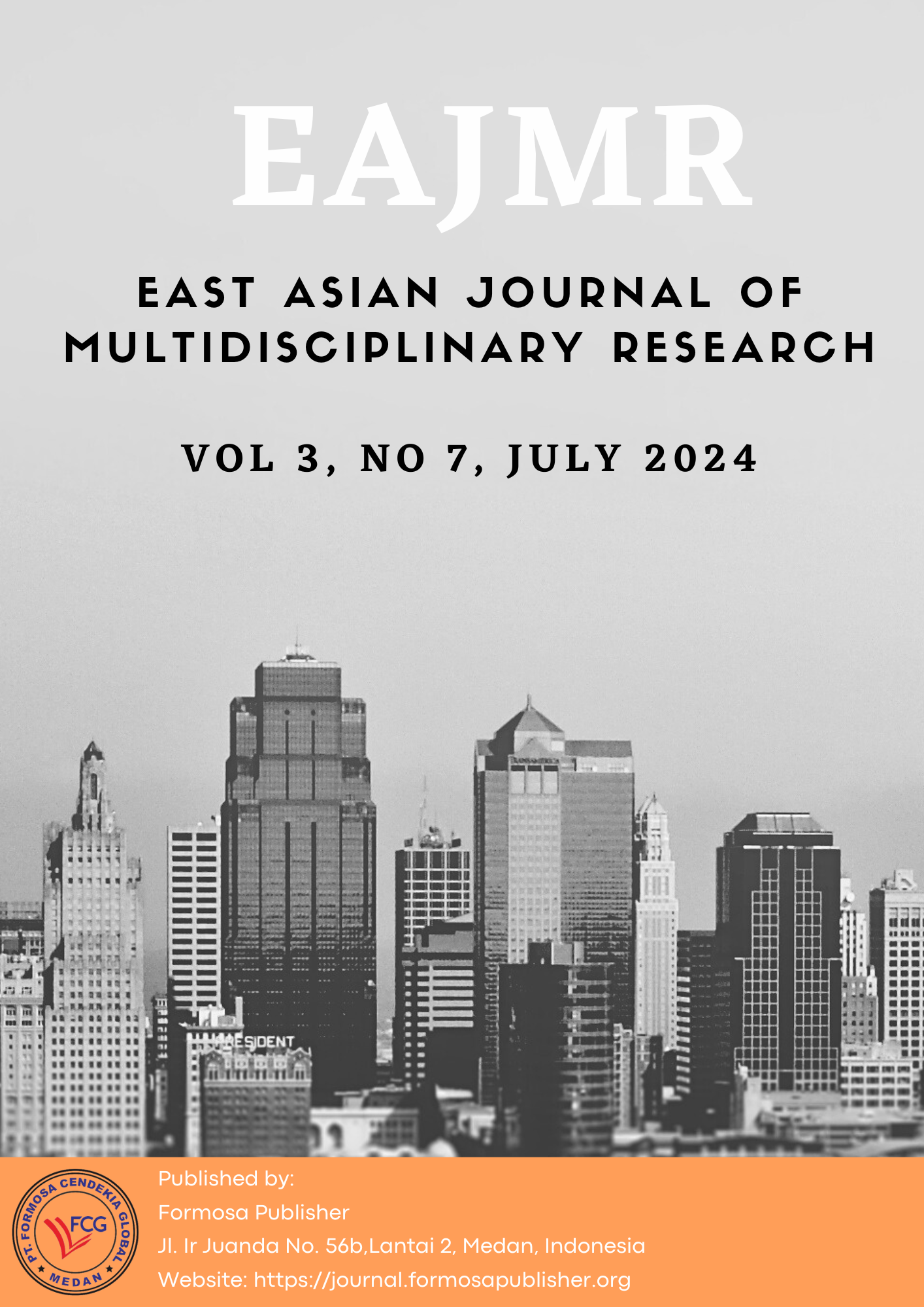Analysis of Indonesia's Cooperation with China Through the Belt and Road Initiative (BRI) can Provide Opportunities or Challenges for Indonesia to Realize the World Maritime Axis
DOI:
https://doi.org/10.55927/eajmr.v3i7.8297Keywords:
Cooperation, Belt and Road Initiative, Opportunities, Challenges, World Maritime AxisAbstract
The World Maritime Axis policy initiated by President Joko Widodo has become one of the government's main focuses in national development in collaboration with the Chinese government through the Belt and Road Initiative (BRI). But sometimes it is also necessary to have a strategy carried out by the government in stemming the threats that come to support the world maritime axis. This has the potential to cause various asymmetrical threats around the economic field and loss of sovereignty, Indonesia's entry into the debt abyss, and the entry of laborers from China to Indonesia which will reduce employment opportunities for indigenous people. The research method uses quantitative data. The basis for the state planning process needs to be carefully prepared. Given that defense is one form of a spectrum of uncertainty that can make a "threat". keep in mind the magnitude of the opponent's ability, and must prepare to overcome the threats that will be posed in the future.
References
Anam, S., & Ristiyani, R. (2018). Kebijakan Belt and Road Initiative (BRI) Tiongkok pada Masa Pemerintahan Xi Jinping. Jurnal Ilmiah Hubungan Internasional,14(2),217–236. https://doi.org/10.26593/jihi.v14i2.2842.217- 236
Dan, T. (2022). PENGARUH BELT AND ROAD INITIATIVE ( BRI ) TERHADAP KERJASAMA EKONOMI Deavalia Pratiwi. Fahrizal, M., Yudilla, A., & Sundari, R. (2019). Konsep Kebijakan One Belt One Road (Obor) China Dalam Kerangka Kerjasama Pembangunan Infrastuktur Di Indonesia. Journal of Diplomacy and International Studies, 77–96. https://journal.uir.ac.id/index.php/jdis/index
Firda Amaliyah, R. M. (2023). Kepentingan Tiongkok Melalui Belt and Road Initiative (BRI) dalam Pembangunan Infrastruktur di Sulawesi Utara 2017- 2022. Jurnal Ilmu Ekonomi Dan Pembangunan, 6(2), 1–14. https://www.ncbi.nlm.nih.gov/books/NBK558907/
Iskandar, R., Ambarwati, A., & Putra, M. I. T. (2022). Analisis Strategi Kebijakan Luar Negeri Indonesia Dalam Belt and Road Initiative. Jurnal Dinamika Global, 7(01), 84–105. https://doi.org/10.36859/jdg.v7i01.961
Kusumawardhana, I. (2023). Diplomasi Triangular China Terhadap Indonesia Dalam TheJournalish: Social and Government, 4(2)173–189. https://doi.org/10.55314/tsg.v4i2.485
Novriyanti, S. (2021). Mengupas Kerja Sama Investasi China di Indonesia. https://money.kompas.com/read/2021/01/13/195028326/mengupas-kerja-sama-investasi-china-di-indonesia
Octorifadli, G. P., Puspitasari, A., Abdul, A., & Azzqy, R. (2021). Kepentingan Tiongkok Terhadap Indonesia Melalui Belt and Road Initiative dalam Pembangunan Kereta Cepat Jakarta-Bandung Periode 2015-2020. Budi Luhur Journal of Contemporary Diplomacy, 5(2), 175–186.
Peace, C. E. F. I. (2023). How Has China’s Belt and Road Initiative Impacted Southeast Asian Countries?
Politi, A. (2021). How Green is China’s Belt and Road Initiative?
Prasad, E., & Rumbaugh, T. (2003). Beyond the Great Wall. Finance and Development, 40(4), 46–49. https://doi.org/10.1126/science.253.5021.743.b
Rakhmat, M. Z. (2020). Indonesia makin bergantung pada Cina dan itu berbahaya: apa yang bisa dilakukan. https://theconversation.com/indonesia-makin- bergantung-pada-cina-dan-itu-berbahaya-apa-yang-bisa-dilakukan-150948
Rakhmat, M. Z., & Purnama, Y. (2023). Polemik Investasi China di Indonesia. Celios.
Rivai, A. N. A. (2023). Ambisi Ekspansi Bisnis Dan Politik Strategis Cina Di Asia Tenggara Melalui Belt Road Initiative: Tinjauan Diplomasi Infrastruktur. Review of International Relations, 4(2), 188–219. https://doi.org/10.24252/rir.v4i2.35041
Rustam, I. (2020). Strategi Maritime Silk Road China dan dampaknya pada Keamanan Maritim Indonesia. Indonesian Journal of Peace and Security Studies (IJPSS), 2(2), 31–50. https://doi.org/10.29303/ijpss.v2i2.44
Saraswati, N. M. V. (2020). Menilik Perjanjian Indonesia-Cina dalam Kerangka Belt and Road Initiative (BRI) dalam Perspektif Ketahanan Nasional. Jurnal Lemhannas RI, 7(2), 55–72.
Siswanto, D. (2023). Indonesia Perlu Waspadai Cengkeraman Utang China.
Wira Wibawati, S., Sari, M. I., & Sulistyani, Y. A. (2018). Potensi Dan Tantangan One Belt One Road (Obor) Bagi Kepentingan Nasional Indonesia Di Bidang Maritim. Jurnal Kajian Wilayah, 9(1), 109–123. https://doi.org/10.14203/jkw.v9i2.801
Wong, V. A. (2019). Sinergitas belt and road initiative berdimensikan the 21. Journal Hubungan International.
Zamroh, M. R. (2020). Posisi Strategis Indonesia Sebagai Poros Maritim Dunia. https://geohepi.hepidev.com/2020/12/15/posisi-strategis-indonesia-sebagai- poros-maritim-dunia/
Downloads
Published
How to Cite
Issue
Section
License
Copyright (c) 2024 Wahyu Gusriandari, Guntur Eko Saputro, Aris Sarjito, M. Rinaldi

This work is licensed under a Creative Commons Attribution 4.0 International License.







.png)





















